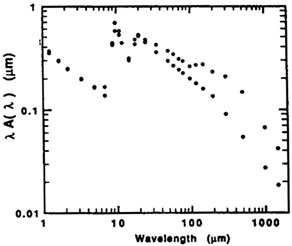


Classical grain models consisting of silicate and carbon grains of radius 0.01-0.1 µ, for example those of Mathis et al (1977), Draine and Lee (1984), Rowan-Robinson (1986), Tielens and Allamandola (1987), are successful in accounting for the observed visible and ultraviolet extinction curve and the emission longward of 60 µ. However there is not yet a concensus on the grain properties longward of 300 µ, as emphasized by Draine (1989). I will discuss this further in section 5 below. The observations which the classical grain model definitely can not account for are (i) excess diffuse emission from the Milky Way at 2-20 µ (Price 1981, Boulanger et al 1985), (ii) 2-20 µ emission from reflection nebulae with color temperature approximately independent of distance from the star (Sellgren 1984) and (iii) the broad features at 3.3, 6.2, 7.7, 8.6 and 11.3 µ seen ubiquitously in emission (Gillett et al 1973).
Current models for these three phenomena all involve the non-equilibrium response of very small particles to absorption of an ultraviolet photon (Greenberg 1968, Duley 1973, Allen and Robinson 1975, Purcell 1976, Andriesse 1978, Sellgren 1984, Draine and Anderson 1985). The main contenders are:
(A) Polycyclic aromatic hydrocarbons (PAH), which can be thought of as hydrogenated graphite platelets consisting of about 50 atoms (Platt 1956, Donn 1968, Leger and Puget 1984, Allamandola et al 1985, Puget and Leger 1989). To account for the full range of observed phenomena, Puget and Leger (1989) have to include also a very small carbonaceous grain (VSG) component with radii in the range 0.0015-0.01 µ. Fig 1a shows how some particular examples of PAHs can give at least qualitative agreement in the wavelengths of (most of) the 3-12 µ broad-band features (Puget and Leger 1989). Fig 1b shows Puget and Legets fit to the interstellar extinction curve in the visible and ultraviolet.

|

|
Figure 1. (a) Emission spectra of several PAHs calculated from their laboratory absorption spectra, compared with observations of the reflection nebula NGC2023. (b) Fit to the interstellar extinction curve (Puget and Leger 1989) |
(B) Hydrogenated amorphous carbon (HAC), which can be thought of as poorly connected PAH islands in a larger structure (Duley and Williams 1981, 1988a, b, Duley 1987, Jones et al 1987, Williams 1989). They attribute the 0.22 µ feature to small silicate particles. Fig 2 shows their fit to the visible and ultraviolet interstellar extinction curve. Broad-band emission in the 0.6-0.9 µm region is attributed to luminescence from a diamond-like component in the HAC (Duley and Williams 1988b).

|
Figure 2. Fit by Jones et al (1987) to the interstellar extinction curve in the visible and ultraviolet. |
(C) Quenched carbonaceous composite (QCC) has been proposed by Sakato et al (1983, 1984). This material is made in the laboratory in a process intended to simulate the expanding atmospheres of carbon stars.
(D) Amorphous aggregates of small particles of silicates, amorphous carbon and graphite (Mathis and Whiffen 1989). These authors show that the optical properties of an aggregate can be significantly different from a simple sum of the ingredients in the aggregate. Fig 3a illustrates the appearance of the Mathis and Whiffen composite grains, Fig 3b shows their fit to the visible and ultraviolet extinction curve and Fig 3c shows the properties of their grains at 1-1000 µ.

|

|

|
Figure 3. Schematic picture of the Mathis & Whiffen (1989) grain model. (b) Their fit to the ultraviolet and visual interstellar extinction curve. (c) The same for infrared wavelengths. (filled circles: calculated, open circles: observations). |
It is clear that in the aggregate models (B-D), the very small grain component must retain its thermodynamic identity in order to explain the phenomena (i-iii) above. From the point of view of understanding infrared emission from dust, it may therefore be academic whether the very small grain component is integrated into a larger structure or not, since this integration must be so weak as to leave the specific properties of the component intact. Puget and Leger (1989) in fact query whether aggregate grain models can localize the energy of an incident photon for the several seconds required for infrared emission.
Draine (1988) has reviewed the variety of models which have been put forward specifically to explain the 0.2175 µ feature. The models which he considers are graphite, nongraphitic carbonaceous solids, OH- on small silicate grains, PAH, small MgO or CaO particles, dessicated microorganisms, radiation-damaged SiO2, charge transfer on Si, Fe or Mg, and finally the absorption edge in silicate grains. He concludes that only two are consistent with all the available observations, graphite or OH- on small silicate grains, and he notes that the latter hypothesis is less well developed than the graphite hypothesis.
In section 5 below I shall try to pull together some of these ingredients into a simple but comprehensive picture for interstellar dust in galaxies.